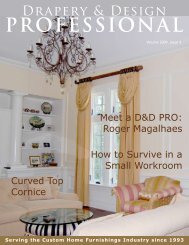nov dec issue FINAL.indd - Custom Home Furnishings Academy
nov dec issue FINAL.indd - Custom Home Furnishings Academy
nov dec issue FINAL.indd - Custom Home Furnishings Academy
You also want an ePaper? Increase the reach of your titles
YUMPU automatically turns print PDFs into web optimized ePapers that Google loves.
Step-by-Step<br />
Chris Watt<br />
Flat Roman Shades<br />
Kicked Up A Notch!<br />
Figure 1: Side Wall Before<br />
Thoughtful planning and vision can<br />
take a “simple” flat Roman shade<br />
and “kick it up a notch” resulting in<br />
an extraordinarily custom shade that<br />
can place your workroom reputation well above<br />
others. Our designers and clients often do not<br />
understand that there is a difference. It is within<br />
our abilities to educate them. But be careful, once<br />
they learn what the possibilities can be, their<br />
expectations (and yours) will never be the same!<br />
I recently completed a job, for Interior Designer, Jo Ann<br />
James, that is a perfect example of such a situation.<br />
The design of the shades—flat Roman shades made out of<br />
paisley fabric with plain contrast 3" bottom banding, the<br />
band exposed 2" when pulled up—was nothing unusual.<br />
However, this job had a number of special circumstances and<br />
illustrates why there are no “standards” for Roman shade<br />
construction in my workroom.<br />
The Project<br />
Window covering for side-by-side windows, Figures 1 and 2.<br />
8 flat Roman shades with contrast hems,<br />
3" exposed when lowered,<br />
2" skirt exposed when raised.<br />
4 shades, 34" x 70" (inside mount).<br />
4 shades, 34" x 92" (outside mount).<br />
The fabric is from Lee Jofa and has a 19.5" repeat.<br />
The Challenge<br />
1. All shades must have consistent fabric repeat placement,<br />
starting at the top.<br />
2. Each fold must have the same pattern placement.<br />
3. The shades must look identical when raised.<br />
4. No face fabric should be visible from the outside of the<br />
home.<br />
5. The clutch lift system must be concealed so it will not be<br />
seen from the outside or inside of the home.<br />
Figure 2: Back Wall Before<br />
The Planning Process<br />
1. Determine the ring spacing overall.<br />
Since the fabric has a 19.5" pattern repeat, I divided<br />
this number by 2 and established the primary spacing at<br />
9.75". This spacing results in every other fold showing<br />
the same pattern at the bottom. (For a 24" or 27" repeat,<br />
consider dividing into thirds, resulting in every third fold<br />
showing the same pattern at the bottom edge. This will<br />
still create a consistent and pleasing pattern of folds when<br />
the shades are raised.)<br />
2. Find a way to get side-by-side shades of different lengths<br />
to look identical when raised.<br />
I had already <strong>dec</strong>ided to start the first row of rings from<br />
the top of the board at 11.75", then space all other rows<br />
every 9.75" (1/2 of 19.5" pattern repeat). The last row<br />
of rings needed to be appropriately placed to reveal 2"<br />
of bottom skirt (the contrast). In a mock-up, I folded the<br />
shade and noted that the flap between the rings is about<br />
half the space between the rings (4 7/8"). I rounded this<br />
up to 5" and determined that to expose 2" of skirt, the<br />
48 The <strong>Custom</strong> <strong>Home</strong> <strong>Furnishings</strong> Magazine November/December 2006






